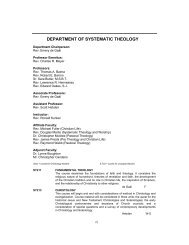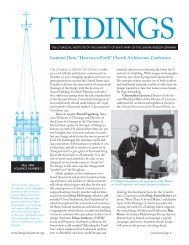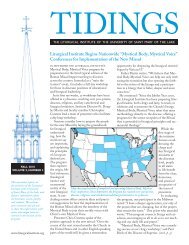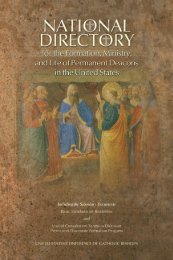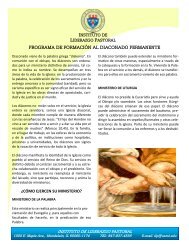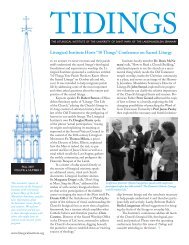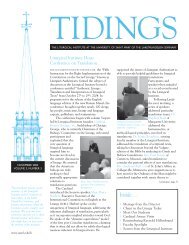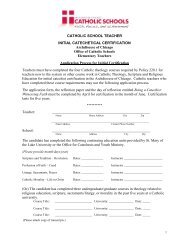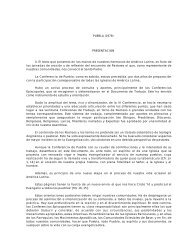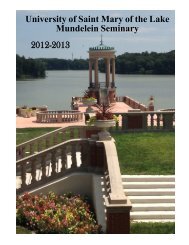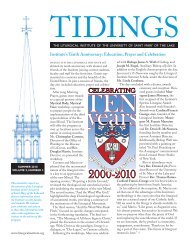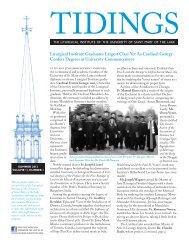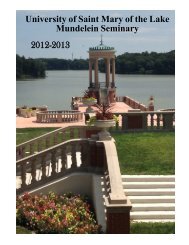The Deacon at Mass Principles
The Deacon at Mass Principles
The Deacon at Mass Principles
Create successful ePaper yourself
Turn your PDF publications into a flip-book with our unique Google optimized e-Paper software.
INSTITUTE FOR DIACONAL STUDIES<br />
<strong>The</strong> <strong>Deacon</strong> <strong>at</strong> <strong>Mass</strong><br />
<strong>Principles</strong><br />
THE EUCHARISTIC SACRIFICE OF THE MASS is the action of Christ (GIRM 11) and of God's<br />
people, in which the human race adores the F<strong>at</strong>her, through Christ, in the Holy Spirit (16), and<br />
the faithful join themselves to Christ in giving thanks and in acknowledging the gre<strong>at</strong> things<br />
God has done (78). <strong>The</strong> <strong>Mass</strong> is the 'sacrament of unity" (91, 92) in which the faithful are<br />
nourished from the table of God's Word and of Christ's Body (28). This unity is expressed<br />
particularly in common posture (42), in communal singing (47), reverential silence (45, 56), and<br />
in sharing together of the one bread and one cup (83, 321). <strong>The</strong> assumption of the Roman Missal<br />
is th<strong>at</strong> every Sunday and feast day, the Eucharistic liturgy will be celebr<strong>at</strong>ed with song (40, 115),<br />
with a cantor (104), with one or two readers (109), and with other assisting ministers (115). It is<br />
also assumed th<strong>at</strong> all communicants present <strong>at</strong> <strong>Mass</strong>, priest celebrant, deacon, ministers and all<br />
in the assembly, will receive the sacrament from bread and wine consecr<strong>at</strong>ed <strong>at</strong> th<strong>at</strong> <strong>Mass</strong> (85,<br />
281, 321), just as the priest celebrant must do (85, 243). <strong>The</strong> liturgical books, particularly those<br />
used by the priest celebrant, the deacon and the assisting ministers should be beautiful and<br />
appropri<strong>at</strong>e to the celebr<strong>at</strong>ion (349) r<strong>at</strong>her than being disposable pages or booklets.<br />
<strong>The</strong> found<strong>at</strong>ional principles explaining the purpose of the parts of the <strong>Mass</strong> are found primarily<br />
in Chapter II (27-90) and this chapter provides the basis for the more detailed norms found in<br />
Chapter IV (112-287). Chapters V (188-318) and VI (319-351) also give general principles<br />
regarding the arrangement of the church and the requisites for <strong>Mass</strong>.<br />
<strong>The</strong> rubrics assume th<strong>at</strong> the celebr<strong>at</strong>ion of <strong>Mass</strong> will take place in a church (288) with a<br />
freestanding altar (299), an ambo for proclaiming God's Word (309), and a presidential chair<br />
used by the priest <strong>at</strong> certain points during the celebr<strong>at</strong>ion (310). Although the tabernacle may be<br />
loc<strong>at</strong>ed in the sanctuary (315b), all the rubrics assume th<strong>at</strong> it is loc<strong>at</strong>ed in a chapel apart from the<br />
sanctuary since they make no reference to it when describing the actions of the priest celebrant<br />
and other ministers during <strong>Mass</strong>. If, however, the tabernacle is loc<strong>at</strong>ed in the sanctuary, all the<br />
ministers genuflect to it only when they first approach the altar and when they leave the<br />
sanctuary, but not during the celebr<strong>at</strong>ion of <strong>Mass</strong> itself (274).<br />
UNIVERSITY of SAINT MARY of THE LAKE | 1
INSTITUTE FOR DIACONAL STUDIES<br />
<strong>The</strong> <strong>Deacon</strong> <strong>at</strong> <strong>Mass</strong><br />
After the priest, in virtue of the sacred ordin<strong>at</strong>ion he has received, the deacon has first place<br />
among those who minister in the celebr<strong>at</strong>ion of the Eucharist. For the sacred order of the<br />
diacon<strong>at</strong>e has been held in high honor in the Church since the time of the Apostles. (1) At <strong>Mass</strong><br />
the deacon proclaims the Gospel reading, sometimes preaches God's Word, announces the<br />
intentions of the General Intercessions, ministers to the priest, prepares the altar and serves the<br />
celebr<strong>at</strong>ion of the sacrifice, distributes the Eucharist to the faithful, especially under the species<br />
of wine, and from time to time gives directions regarding the people's gestures and posture<br />
(GIRM, 94).<br />
<strong>Mass</strong> with a <strong>Deacon</strong><br />
When there is a deacon present <strong>at</strong> the Eucharistic celebr<strong>at</strong>ion, he should exercise his ministry<br />
wearing sacred vestments. (1) <strong>The</strong> deacon:<br />
A) assists the priest and processes <strong>at</strong> his side (unless he is carrying the Book of the Gospels, in<br />
which case, he precedes the priest);<br />
B) ministers the chalice or the book (Roman Missal) <strong>at</strong> the altar;<br />
C) proclaims the Gospel and, <strong>at</strong> the request of the priest celebrant, may preach the homily<br />
(see GIRM no. 55);<br />
D) gives timely directions to the faithful and announces the intentions in the General<br />
Intercessions;<br />
E) assists the priest celebrant in distributing Communion, especially as minister of the<br />
Precious Blood, and cleanses and arranges the sacred vessels;<br />
F) as needed, performs the offices of other ministers when none of them are present<br />
(GIRM, 171).<br />
Introductory Rites<br />
<br />
<br />
<br />
<br />
Vested and carrying the Book of the Gospels slightly elev<strong>at</strong>ed, the deacon precedes the<br />
priest on the way to the altar or else walks <strong>at</strong> the priest's side if the Book of the Gospels is<br />
already enshrined on the altar (172).<br />
Upon arriving <strong>at</strong> the altar, if he is carrying the Book of the Gospels, the deacon omits the<br />
reverence and goes up to the altar.<br />
After placing the Book of the Gospels on it, along with the priest, he vener<strong>at</strong>es the altar<br />
with a kiss. However, if he is not carrying the Book of the Gospels, he customarily makes a<br />
profound bow to the altar with the priest alone, and then with him vener<strong>at</strong>es the altar<br />
with a kiss. If, however, the tabernacle is loc<strong>at</strong>ed in the sanctuary, all the ministers<br />
genuflect to it only when they first approach the altar and when they leave the<br />
sanctuary, but not during the celebr<strong>at</strong>ion of <strong>Mass</strong> itself (274). Finally, if incense is used,<br />
he assists the priest in putting some in the censer and incensing the cross and the altar<br />
(173).<br />
After the incens<strong>at</strong>ion, the deacon goes to the chair with the priest, sits next to him, and<br />
assists him as required (GIRM, no. 174).<br />
UNIVERSITY of SAINT MARY of THE LAKE | 2
INSTITUTE FOR DIACONAL STUDIES<br />
Liturgy of the Word<br />
<br />
<br />
<br />
<br />
<br />
<br />
<br />
<br />
<br />
<br />
<br />
<br />
<strong>The</strong> <strong>Deacon</strong> <strong>at</strong> <strong>Mass</strong><br />
If incense is used, the deacon assists the priest when he puts incense in the censer during<br />
the singing of the Alleluia or other chant.<br />
<strong>The</strong>n he makes a profound bow before the priest and asks for the blessing, saying in a<br />
low voice: "Your blessing, F<strong>at</strong>her." <strong>The</strong> priest blesses him: "<strong>The</strong> Lord be in your heart …."<br />
<strong>The</strong> deacon signs himself with the sign of the cross and responds: Amen.<br />
<strong>The</strong>n he takes the Book of the Gospels which was fittingly laid on the altar and, with a bow<br />
to the altar, processes to the ambo, slightly elev<strong>at</strong>ing the book, with the censer bearer<br />
preceding him, while the censer is smoking, and with ministers holding lighted candles.<br />
<strong>The</strong>re he greets the people, saying, with his hands joined: "<strong>The</strong> Lord be with you," and<br />
then, "A reading from the Holy Gospel …" signing the book with his thumb and afterwards,<br />
himself on his forehead, mouth and breast.<br />
He incenses the book and proclaims the Gospel reading.<br />
After the reading, he acclaims without raising the Book of the Gospels: "<strong>The</strong> Gospel of the<br />
Lord," to which all respond: "Praise to you, Lord Jesus Christ."<br />
<strong>The</strong>n he vener<strong>at</strong>es the book with a kiss and the deacon says inaudibly: "Through the<br />
words of the gospel may our sins be wiped away." He then returns the book to the priest or<br />
places it in another suitable place.<br />
When the deacon is assisting a Bishop, he may carry the book to him to be kissed.<br />
In more solemn celebr<strong>at</strong>ions, as circumstances allow, the Bishop may impart a blessing<br />
to the people with the Book of the Gospels.<br />
<strong>The</strong>n the deacon carries the Book of the Gospels to the side table or another dignified and<br />
appropri<strong>at</strong>e place (175). If there is no other qualified reader present, then the deacon<br />
may deliver the other readings as well (176). However, every effort should be made to<br />
insure the presence of lectors for the celebr<strong>at</strong>ion of the Eucharistic liturgy.<br />
After the priest introduces the General Intercessions, the deacon announces the intentions<br />
from the ambo or another suitable place (177). He remains <strong>at</strong> the ambo while the priest<br />
concludes the General Intercessions with a prayer.<br />
At the conclusion of this prayer, the deacon begins the prepar<strong>at</strong>ion of the altar.<br />
Some IMPORTANT REMINDERS in the Archdiocese of Chicago:<br />
A ‘profound’ bow is from the waist and not the head;<br />
<strong>Deacon</strong>s hand the p<strong>at</strong>en with the unconsecr<strong>at</strong>ed host to the priest and do not place<br />
it on the altar – and then they may begin pouring wine into the chalice;<br />
<strong>Deacon</strong>s stand slightly behind but next to the priest <strong>at</strong> the altar;<br />
DEACONS KNEEL from the epiclesis (priest extends hands over gifts just prior to<br />
consecr<strong>at</strong>ion) to anamnesis (<strong>The</strong> mystery of faith…);<br />
<strong>Deacon</strong>s never extend hands (‘orans’ – even if families do this <strong>at</strong> the ‘Our F<strong>at</strong>her’)<br />
nor make any bows when kneeling <strong>at</strong> the consecr<strong>at</strong>ion. <strong>Deacon</strong>s stand up straight<br />
with hands folded facing forward – do not turn to look <strong>at</strong> the celebrant.<br />
At the doxology of the Eucharistic prayer (Through Him, and with Him…) the<br />
deacon receives the cup from the celebrant and does not pick it up himself – and<br />
faces forward. Do not turn toward the celebrant.<br />
UNIVERSITY of SAINT MARY of THE LAKE | 3
INSTITUTE FOR DIACONAL STUDIES<br />
Liturgy of the Eucharist<br />
<strong>The</strong> <strong>Deacon</strong> <strong>at</strong> <strong>Mass</strong><br />
<br />
<br />
<br />
<br />
<br />
<br />
<br />
<br />
<br />
<br />
<br />
After the General Intercessions, while the priest remains <strong>at</strong> the chair, the deacon prepares<br />
the altar, assisted by the acolyte(s), but the care of the sacred vessels belongs to the<br />
deacon. He assists the priest in receiving the people's gifts in a suitable place.<br />
Next, he hands the priest the p<strong>at</strong>en with the bread to be consecr<strong>at</strong>ed, pours wine and a<br />
little w<strong>at</strong>er into the chalice saying inaudibly: "By the mystery of this w<strong>at</strong>er and wine …,"<br />
then passes the chalice to the priest.<br />
He may also make this prepar<strong>at</strong>ion of the chalice <strong>at</strong> the side table.<br />
If incense is used, the deacon assists the priest with the incens<strong>at</strong>ion of the gifts, the cross<br />
and the altar; afterward he, or the acolyte, incenses the priest and the people (178).<br />
During the Eucharistic Prayer, the deacon stands near but slightly behind the priest, so<br />
th<strong>at</strong> when needed he may assist the priest with the chalice or the Roman Missal.<br />
As a general rule, from the epiclesis until the elev<strong>at</strong>ion of the chalice the deacon remains<br />
kneeling. If there are several deacons present, one of them goes to place incense in the<br />
censer for the consecr<strong>at</strong>ion and then incenses <strong>at</strong> the elev<strong>at</strong>ion of the host and the chalice<br />
(179).<br />
At the final doxology of the Eucharistic Prayer, the deacon stands next to the priest, and<br />
after the priest (or Bishop) hands him the chalice, he elev<strong>at</strong>es the chalice as the priest<br />
raises the p<strong>at</strong>en with the Eucharistic bread, until the people have responded with the<br />
acclam<strong>at</strong>ion Amen (180).<br />
After the priest has said the prayer for peace and the greeting "<strong>The</strong> peace of the Lord be<br />
with you always" and the people have made the response "And also with you," the deacon<br />
may invite all to exchange the sign of peace, saying, with hands joined and facing the<br />
people: Let us offer one another a sign of peace. He himself receives the sign of peace from<br />
the priest and may offer it to the other ministers near him (181).<br />
After the priest's communion, the deacon receives under both kinds from the priest<br />
himself and then assists the priest in giving communion to the people. But if communion<br />
is given under both kinds, the deacon ministers the chalice.<br />
When the distribution is completed, the deacon immedi<strong>at</strong>ely and reverently consumes <strong>at</strong><br />
the altar all of the Blood of Christ which remains; he may be assisted, if needs dict<strong>at</strong>e, by<br />
other deacons and priests (182) or, in their absence, by Extraordinary Ministers of Holy<br />
Communion (Norms for the Distribution and Reception of Holy Communion in the Dioceses of<br />
the United St<strong>at</strong>es of America, no. 37).<br />
After communion, the deacon returns to the altar with the priest and collects any<br />
remaining fragments. He then takes the chalice and other vessels to the side table, where<br />
he cleanses them and arranges them in the usual way; the priest returns to the chair. But<br />
it is permissible to leave the vessels to be cleansed, suitably covered and <strong>at</strong> a side table<br />
on a corporal, immedi<strong>at</strong>ely after <strong>Mass</strong> following the dismissal of the people (183).<br />
KNEELING during the consecr<strong>at</strong>ion IS THE REVERENT POSITION<br />
for the deacon (with no bows). If a deacon is physically unable to kneel,<br />
he should reverently stand up straight with hands folded. Neither<br />
parishes nor groups of deacons may alter this form<strong>at</strong> (in other words,<br />
no group decisions to all stand r<strong>at</strong>her than kneel).<br />
UNIVERSITY of SAINT MARY of THE LAKE | 4
INSTITUTE FOR DIACONAL STUDIES<br />
<strong>The</strong> <strong>Deacon</strong> <strong>at</strong> <strong>Mass</strong><br />
Concluding Rite<br />
<br />
<br />
<br />
<br />
Following the Prayer after Communion, if there are any brief announcements, the deacon<br />
may make them, unless the priest prefers to do so himself (184).<br />
If a more solemn formula for the blessing is used, or even a prayer over the people, the<br />
deacon says: "Bow your heads and pray for God's blessing."<br />
After the priest's blessing, the deacon, with hands joined and facing the people,<br />
dismisses them, saying: "Go in the peace" or using one of the other formulas of the Roman<br />
Missal (185).<br />
Along with the priest, the deacon vener<strong>at</strong>es the altar with a kiss, makes a profound bow,<br />
(2) and leaves in the manner prescribed for the entrance procession (186).<br />
Notes<br />
1. See Paul VI, Apostolic Letter, Sacrum diacon<strong>at</strong>us ordinem, AAS 59 (1967), 697-704; Roman Pontifical, De<br />
Ordin<strong>at</strong>ione Episcopi, presbyterorum et diaconarum, editio typica altera, 1989, no. 173.<br />
2. If there is a tabernacle in the sanctuary, all genuflect.<br />
Third Edition Roman Missal / From the Committee on Divine Worship USCCB 2011<br />
UNIVERSITY of SAINT MARY of THE LAKE | 5



